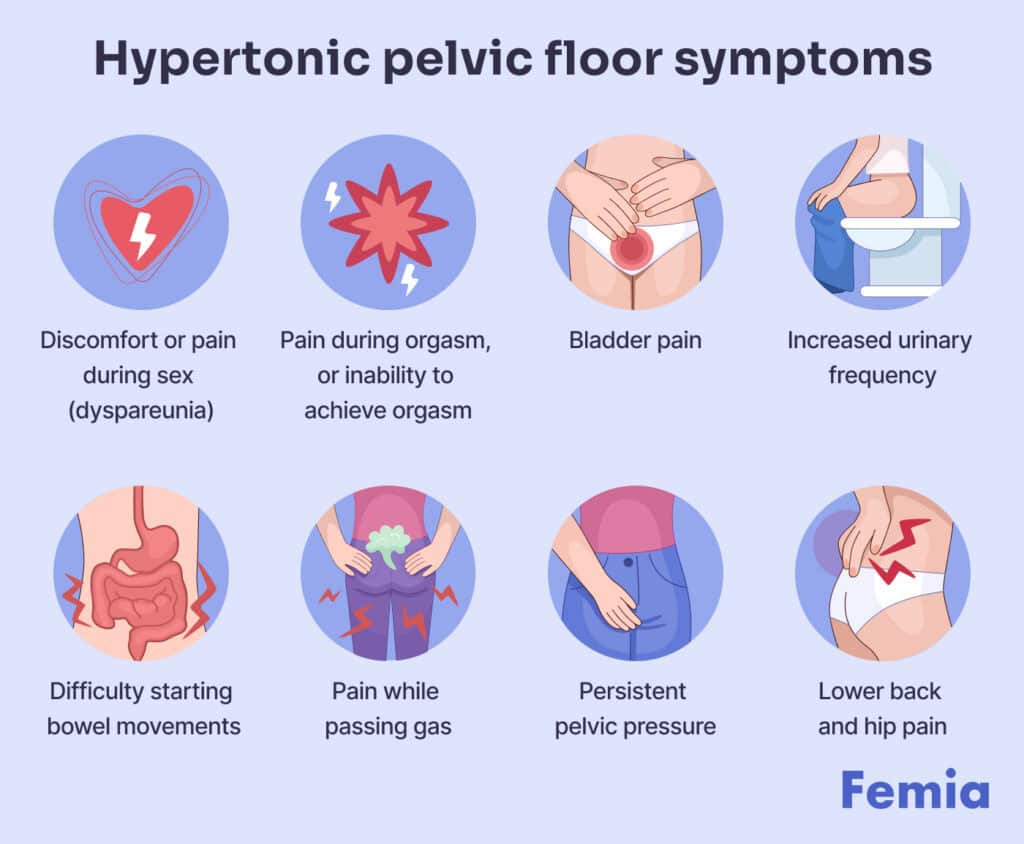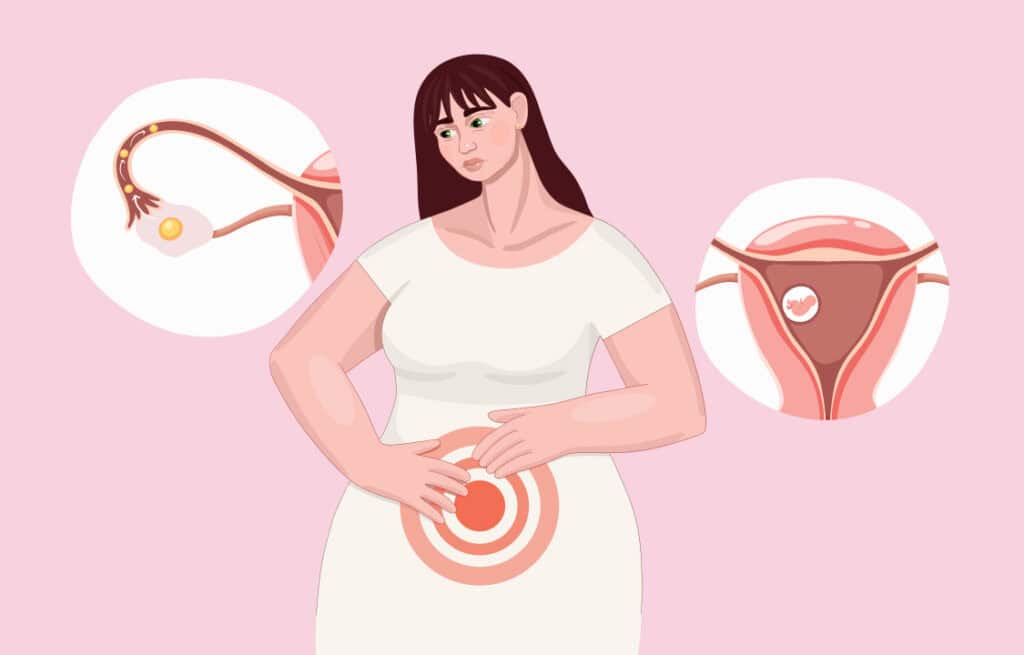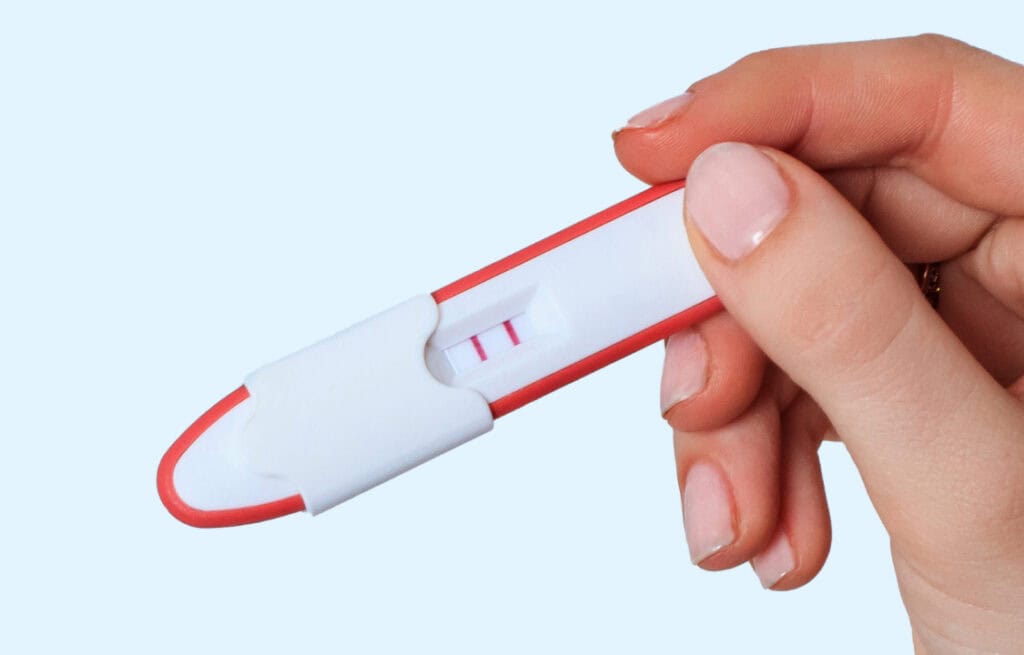Femia > Health Library > Your cycle > Health > Hypertonic pelvic floor: Symptoms, causes and how to find relief
Hypertonic pelvic floor: Symptoms, causes and how to find relief

- Updated Feb 11, 2025
- Published
CRAFTED BY HUMAN
Crafted by human At Femia, we provide accurate and up-to-date information at every stage of your journey, from trying to conceive, pregnancy and postnatal support. All content is created by a real person based on in-depth research and own professional experience. Femia ensures that you will receive expert advice, strict accuracy and a personalized approach from our authors/medical experts. Learn more about our editorial policy.
FACT CHECKED
Fact checked At Femia Health, we maintain the highest standards of editorial excellence in delivering content focused on helping you conceive, guiding you through pregnancy, and supporting you postpartum. Explore our content review principles to learn how we ensure the accuracy and quality of our health and lifestyle tips for every stage of your journey.

Created with Hector Chapa, MD, FACOG, Clinical associate professor, Obstetrics and Gynecology Texas A&M University, College of Medicine in Bryan-College Station, USA
A hypertonic pelvic floor is when the supporting muscles in your pelvis have increased tone, meaning they are unable to relax after contraction. Since your vagina, bladder, and rectum are supported by your pelvic floor, symptoms related to a tight pelvic floor present with pain and related dysfunction. After a consultation with your doctor, treatment options may include lifestyle changes, pelvic floor physical therapy, and pelvic floor exercises.
Your pelvic floor lies at the lowest part of your abdomen, supporting organs such as your uterus, bladder, and bowels. Pelvic muscle tone is important for controlling how the muscle contracts and relaxes. Being able to both contract and relax these muscles helps with organ function, such as urination, defecation, and sexual health. Having a hypertonic pelvic floor, while causing you pain, can also affect these basic functions. In this article, we will explore what a hypertonic pelvic floor is, what underlying causes may be at fault, what signs to look out for, and what individualized treatment options are available for you.
Femia helps you understand your body symptoms
and know when to take action
What is a hypertonic pelvic floor?
Hypertonic pelvic floor is when the muscles in your pelvic floor are in a consistent state of tension with an inability to relax. 50–90% of women have urological, gynecological, gastrointestinal, and sexual health concerns resulting from a hypertonic pelvic floor.
In comparison, pelvic floor dysfunction, referring to a weakened pelvic floor, is when you are unable to contract your pelvic floor muscles adequately. This condition has a higher prevalence, since factors such as age, number of pregnancies, vaginal delivery, trauma, and menopause influence it. Symptoms of a weak pelvic floor include:
- Urinary incontinence (while coughing or laughing)
- Limitations in sexual function
- Fecal incontinence
- Pelvic organ prolapse (movement of the organs out of their position)
While consistent and progressive pain can be one of the signs of a tight pelvic floor, you will soon see what the additional symptoms of a tight pelvic floor are in the following sections.
👉Find out more: Bloating during ovulation: Causes, symptoms, and how to relieve discomfort
High tone pelvic floor dysfunction: How it affects women
A Spanish study among 1,446 women, concluded that having a pelvic floor disorder negatively impacted quality of life in a measurable way. This was scored based on difficulties such as urological symptoms, sexual dysfunction, colorectal symptoms, or pelvic organ prolapse.
Initially, it may be difficult to understand what the underlying source of your symptoms is. Many women experience pain, which can be worsened during sex or while passing urine or stool. These are early signs of a tight pelvic floor. Over time, you may also notice a change in the frequency you take your bathroom breaks or lifestyle changes, like rethinking your social commitments or avoiding sex, because of the resulting discomfort.
While hypertonic pelvic floor can be distressing, it should be reassuring to know that is manageable, allowing you to move back to your normal lifestyle.
Signs of a tight pelvic floor
In 60–90% of women who report chronic pelvic pain, high-tone pelvic floor dysfunction is seen as an underlying cause. Often the only sign you may have of a weakened hypertonic pelvic floor is pain.
Pain can be heightened during:
- Defecation
- Urination
- Sex
- Insertion of a tampon or menstrual cup
Having a hypertonic pelvic floor results in you having to place more strain on your pelvis while urinating or defecating. So, you may soon avoid using the bathroom frequently with concerns of pain. This, however, increases pressure and worsens underlying symptoms.
Hypertonic pelvic floor symptoms

Along with pain, having a hypertonic pelvic floor can result in the following symptoms over time:
- Discomfort or pain during sex (dyspareunia)
- Pain during orgasm, or inability to achieve orgasm
- Bladder pain
- Increased urinary frequency
- Difficulty in starting a bowel movement
- Pain while passing gas
- Persistent pressure and feeling of fullness in the lower pelvis
- Lower back and hip pain
You may have a combination of the symptoms listed above. Without proper treatment, symptoms can worsen, and you may develop new hypertonic pelvic floor symptoms. If you experience any of the symptoms listed above, be sure to check in with your doctor at the earliest to prevent the worsening of your underlying condition.
Causes of tight pelvic floor muscles
While the exact reason for your tight pelvic floor muscles may not be so easy to figure out, certain causes, especially from your past medical history, can contribute.
- If you have had pelvic surgery or traumatic pregnancy delivery
- Multiple pregnancies and deliveries
- Prolonged constipation
- Postural or gait abnormalities
- Improper exercise techniques
- Chronic stress or anxiety causing muscle tension
- History of sexual abuse
- Underlying medical conditions such as IBS, endometriosis, or colitis
While a certain cause can be a trigger, often the complex connection between causes is responsible for a hypertonic pelvic floor.
Studies have also looked into potential cross-organ sensitization. One such study observed cross-sensitization between the uterus and pelvic-urethra reflex, frequently associating pelvic pain syndromes with lower urinary tract dysfunctions.
Hypertonic pelvic floor treatment
If you have noticed persistent hypertonic pelvic floor symptoms, consider checking in with your physician for individualized care.
Pelvic floor physical therapy
Both in-clinic or at-home physical therapy will be the initial treatment option for your tight pelvic floor. One literature review of clinical studies highlighted the positive effectiveness of pelvic floor physical therapy as a treatment strategy. Initially, a physical therapist will guide you on how to relax your pelvic floor. They will also recommend exercises you can practice at home. You will notice symptom improvement after a few weeks of consistent practice.
Biofeedback training
During physical therapy, you will also learn to train your pelvic floor to relax. Since a hypertonic pelvic floor is in a consistently contracted state, you will have to re-educate your muscles through biofeedback training. With time, this can significantly improve the pain and urgency experienced with chronic pelvic pain from a tight pelvic floor.
Trigger point therapy
Certain therapies can target the specific trigger points in your pelvic muscles causing your hypertonicity. While physical therapy focusing on trigger points is the first non-invasive method, dry-needling or trigger point injections with an anesthetic or Botox are among the other options available to reduce hypertonic pelvic pain.
Lifestyle therapy
If your posture or long hours of sitting are contributing to your pelvic floor hypertonicity, consider lifestyle modifications, which can help you focus on improving your symptoms. Take frequent breaks, add ergonomic devices (such as chairs, pelvic/hip muscle trainers), and include regular exercise to reduce muscle tension. Additionally, actively manage stress, which is a known contributor to your overall muscle tension.
Femia helps you understand your body symptoms
and know when to take action
Hypertonic pelvic floor exercises
Pelvic floor exercises can be practiced at home and can help reduce the tension in your pelvic floor muscles. You may initially require the guidance of your physical therapist to understand whether you are using the right muscles and form and prevent injury, which can worsen high-tone pelvic floor dysfunction.
Diaphragmatic breathing
Diaphragmatic breathing, also known as deep belly breathing, is a focused method of breathing that helps with pelvic health. When you are mindful of your breathing, taking deep breaths, you inhale more, extending diaphragm contraction. At the other end of your abdomen, your pelvic floor muscles relax, favoring deep breathing. Belly breathing increases awareness of muscles in the pelvis, which helps with biofeedback training, especially for a tight pelvic floor.
Pelvic floor drops
Mindful contraction and relaxation of the pelvic floor muscles can take some getting used to. While it is easier to feel your muscles contract, practiced through the Kegel exercises, it is not always easy to sense their relaxation phase. Reverse Kegel exercises are beneficial here. The reverse Kegels feel a little like bearing down or opening up of your pelvis. You focus on the relaxed lengthening phase, which aims to reduce pelvic floor hypertonicity.
Child’s pose or happy baby pose
A small cohort of women experiencing pelvic floor dysfunction was observed to study the benefit of regular yoga practice over six weeks. By the end of six weeks, most women recorded an improvement in their activities of daily living, emotional well-being, and sexual functioning after suffering from prolonged chronic pelvic pain. Regular yoga practice especially poses like the happy baby pose and child’s pose, emphasizes your awareness of various pelvic floor muscle groups. The slow and focused method of yoga contributes to pelvic pain reduction caused by a hypertonic pelvic floor.
👉Find out more: Cycle syncing: Optimize your lifestyle with your menstrual cycle phases
When to seek help
If you experience persistent pain that increases with urination, defecation, or sex, consult with your doctor. Discomfort with a hypertonic pelvic floor can be intermittent and progressive. So, over time, tight pelvic floor symptoms can worsen if left untreated.
Your doctor will suggest individualized care options for your specific concerns. You will also be guided to a physical therapist who specializes in managing pelvic floor dysfunction. Based on the degree of pelvic floor hypertonicity, you will be recommended exercises you can do at home, after initial guidance on the right ways to practice them to limit further injury.
During treatment, if you notice worsening of symptoms or the onset of new symptoms, be sure to talk to your doctor at the earliest.
Questions from the Femia community
Can a tight pelvic floor affect my fertility?
Having a tight pelvic floor can result in pain during intercourse, which may cause you to avoid sex. However, on its own, a hypertonic pelvic floor shouldn’t interfere with your ability to get pregnant. Talk to your doctor if you have been unable to get pregnant even after regular intercourse.
Can I do Kegels if I have a tight pelvic floor?
Kegel exercises focus on the contraction of the pelvic floor. These exercises are beneficial for women who have a weakened pelvic floor. With a hypertonic pelvic floor, Kegels may worsens symptoms. Reverse Kegels, however, focus on the lengthening of the pelvic floor and are beneficial for high-tone pelvic floor dysfunction.
Will I require surgery to fix a hypertonic pelvic floor?
Surgery is rarely a requirement for treating a hypertonic pelvic floor. Physical therapy and short-term trigger therapy can effectively manage your symptoms. If your symptoms are persistent, worsen, or come back, your doctor may consider surgery if necessary.
The bottom line
Hypertonic pelvic floor symptoms have a 50–90% prevalence. The most common symptom is pelvic pain. While having a tight pelvic floor can contribute to a significant deterioration in your quality of life, it is reassuring to know there are several ways to help improve your tight pelvic floor symptoms.
Following a check-in with your doctor, you will be advised to start physical therapy, which will teach you to relax your pelvic floor, using biofeedback therapy to re-educate pelvic floor muscles. Additionally, you can include a regular practice of pelvic floor exercises to sustain control over your pelvic floor muscles. Early identification and treatment for your hypertonic pelvic floor help prevent further complications.
References
- Van Reijn-Baggen, Daniëlle A., et al. “Pelvic Floor Physical Therapy for Pelvic Floor Hypertonicity: A Systematic Review of Treatment Efficacy.” Sexual Medicine Reviews, vol. 10, no. 2, June 2021, pp. 209–30. https://doi.org/10.1016/j.sxmr.2021.03.002.
- Peinado-Molina, Rocío Adriana, et al. “Pelvic Floor Dysfunction: Prevalence and Associated Factors.” BMC Public Health, vol. 23, no. 1, Oct. 2023, https://doi.org/10.1186/s12889-023-16901-3.
- Torosis, Michele, et al. “A Treatment Algorithm for High-Tone Pelvic Floor Dysfunction.” Obstetrics and Gynecology, Feb. 2024, https://doi.org/10.1097/aog.0000000000005536.
- Faubion, Stephanie S., et al. “Recognition and Management of Nonrelaxing Pelvic Floor Dysfunction.” Mayo Clinic Proceedings, vol. 87, no. 2, Feb. 2012, pp. 187–93. https://doi.org/10.1016/j.mayocp.2011.09.004.
- Rudick, Charles N., et al. “Organ Cross Talk Modulates Pelvic Pain.” AJP Regulatory Integrative and Comparative Physiology, vol. 293, no. 3, July 2007, pp. R1191–98. https://doi.org/10.1152/ajpregu.00411.2007.
- Peng, Hsien-Yu, et al. “Estrous Cycle Variation of TRPV1-mediated Cross-organ Sensitization Between Uterus and NMDA-dependent Pelvic-urethra Reflex Activity.” AJP Endocrinology and Metabolism, vol. 295, no. 3, June 2008, pp. E559–68. https://doi.org/10.1152/ajpendo.90289.2008.
- Van Reijn-Baggen, Daniëlle A., et al. “Pelvic Floor Physical Therapy for Pelvic Floor Hypertonicity: A Systematic Review of Treatment Efficacy.” Sexual Medicine Reviews, vol. 10, no. 2, June 2021, pp. 209–30. https://doi.org/10.1016/j.sxmr.2021.03.002.
- Chiang, Ching-Hsiang, et al. “Therapeutic Efficacy of Biofeedback Pelvic Floor Muscle Exercise in Women With Dysfunctional Voiding.” Scientific Reports, vol. 11, no. 1, July 2021, https://doi.org/10.1038/s41598-021-93283-9.
- Lin, Aaron, et al. “A Critical Review of Interventional Treatments for Myofascial Pelvic Pain.” The Journal of the International Society of Physical and Rehabilitation Medicine, vol. 5, no. 2, Apr. 2022, pp. 41–45. https://doi.org/10.4103/jisprm.jisprm-000143.
- Huang, Alison J., et al. “Development and Feasibility of a Group-Based Therapeutic Yoga Program for Women With Chronic Pelvic Pain.” Pain Medicine, vol. 18, no. 10, Oct. 2016, pp. 1864–72. https://doi.org/10.1093/pm/pnw306.

Learn how ovulation and implantation cramps differ in timing, spotting and pain.

Explore getting pregnant at 40 and learn everything about fertility treatments and pregnancy at 40. Discover expert tips to optimize fertility and navigate age-related challenges.

If I’m still having periods at 55, can I get pregnant? A perimenopause pregnancy is still possible, but much more complex than earlier in life.
